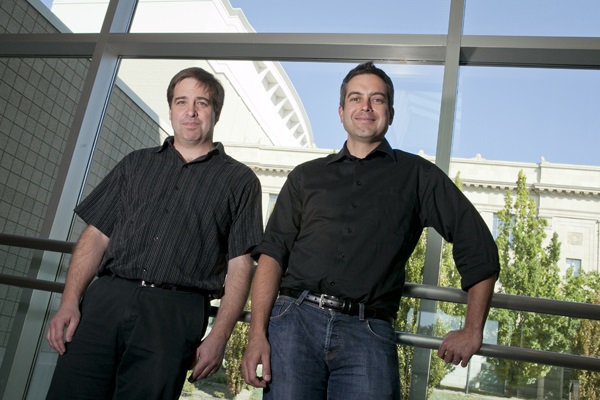
Brunch for the Ears: The NOVA Chamber Music Series
Community
The new season of the NOVA Chamber Music Series began in October with a perfect illustration of the mission of this little arts group: pairing the most classical of classical chamber music––Mozart––with two virtuosic (read: devilishly hard to play) pieces by Utah composer Bruce Quaglia.
The NOVA Chamber Music Series plays local and very new music in increasingly close measure with the rest of the program’s adventurous, but also canonical, repertoire. According to Jason Hardink, current artistic director of NOVA, this is a continuation of previous director Corbin Johnston’s vision for the series: “This makes NOVA a venue unlike any other musical presenter in town in terms of combining old and new music in a way that makes you hear them both differently. It enriches your experience by putting a Utah composer’s piece beside a piece by Tchaikovsky, because you hear them both side by side. Unlike other arts groups, we try to be both old and new, and not just one or the other,” he says.
NOVA was founded in 1977 by Utah Symphony clarinet player, Russell Harlow. “From [Nova’s] first year, when it commissioned a piece by Ramiro Cortés (who was Stravinsky’s secretary and arranger), it has been about the new, as its name implies,” says Hardink. The tradition of commissioned new music continues through this year’s penultimate show, featuring world premieres by two Utah composers: Miguel Chuaqui and Morris Rosenzweig.
We had a chance to talk to composer Miguel Chuaqui, whose computer-aided musical electronics helped make last January’s rendition of “Anthèmes II,” by Boulez, such a monster.
Chuaqui writes music, he says, “as an interaction between who you are, your background and the things going on in your life at the time, and also who you are writing for. You are responding to a performer, and these two come together as an inner experience … Which expresses itself in the music.” Chuaqui composes music for orchestras and small groups, as well as for electronic instruments. He has also collaborated on interactive dance systems, and he helped develop software for interactive musical therapy systems with the University of Utah Hospital.
Though he grew up in Chile, Chuaqui doesn’t want to be “that folk tune guy.” He says, “Just like we don’t grow up with square dance, I didn’t grow up with that music, necessarily … But we wear that rhythm on our sleeve … There is always just something there with all the South Americans.” But, he says, he is loosening up as he gets older and more sentimental. “I’m going along writing, and I notice something in the music that reminds me of an old tune, and then I’ll use it like a jazz musician working a familiar part into an ad lib,” he says. On the question of difficulty, or the virtuosic quality of a piece, he says, “[I] never set out to write music that is hard to play, but it becomes that way pretty quickly. Except for some children’s pieces, pretty much everything I write is challenging.”
Chuaqui’s piece “Confabulario for Wind Quintet” will be performed in the March 17 lineup. “Confabulario,” he says, means “to make up stories,” and the composition, as it evolved, was filled with the memory of voices telling stories and arguing in the Chile of his youth. This composition grew over a year and a half into a very personal work. “It began as a harmonically tight, little piece. Then I loosened it up, let it breathe, and this became the first movement,” he says, adding that it is expressed as a memory of friends and family in the voices of the instruments. “The second movement came very quickly last summer,” he says.
Using some DJ-reminiscent time changes and reverberating fades, he augments the normal ideas for these instruments, taking a set of musical accusations and then differently recounting the story. Now changed in the telling, he invokes a meditation on memory and on the transmutation from the known to the remembered––the creation of “Confabulario.”
As an innovative composer, Chuaqui says, “I’m in the fortunate position to be in demand.” When not writing for traditional ensembles, he writes pieces for electronics and instruments, a kind of bionic music. When he writes electronic music, Chuaqui sees himself setting up tasks for musicians inside an electronic sort of form, which the musician has to see, to line up with and to interact with––sometimes by playing into a microphone, which changes the instrument in time or in sound, other times by playing against pre-programmed electronic events, and sometimes both.
This season’s NOVA concerts include many major new pieces by other local and international composers. Fans of modern lied will be enraptured by the January 20 concert, pairing Schoenberg’s “Pierrot Lunaire” with what will certainly be a super wild piece of very contemporary music, “The Distance (This)” by Jason Eckardt. The Schoenberg, even though it is 100 this year, still sounds wild and new. The final show in April will be a Utah premiere of Curtis Curtis-Smith’s compositions for sonorous piano (meaning a piano played with a bow).
Don’t miss your chance to see these exciting new and newer works. The NOVA series runs through April and is held Sundays at the Libby Gardner Hall on the University of Utah campus. Each show is reviewed by yours truly on the SLUG website. For ticket information and concert details visit Nova’s official website.
.jpg)
